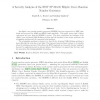Free Online Productivity Tools
i2Speak
i2Symbol
i2OCR
iTex2Img
iWeb2Print
iWeb2Shot
i2Type
iPdf2Split
iPdf2Merge
i2Bopomofo
i2Arabic
i2Style
i2Image
i2PDF
iLatex2Rtf
Sci2ools
CRYPTO
2007
Springer
2007
Springer
A Security Analysis of the NIST SP 800-90 Elliptic Curve Random Number Generator
An elliptic curve random number generator (ECRNG) has been approved in a NIST standards and proposed for ANSI and SECG draft standards. This paper proves that, if three conjectures are true, then the ECRNG is secure. The three conjectures are hardness of the elliptic curve decisional Diffie-Hellman problem and the hardness of two newer problems, the x-logarithm problem and the truncated point problem. The x-logarithm problem is shown to be hard if the decisional Diffie-Hellman problem is hard, although the reduction is not tight. The truncated point problem is shown to be solvable when the minimum amount of bits allowed in NIST standards are truncated, thereby making it insecure for applications such as stream ciphers. Nevertheless, it is argued that for nonce and key generation this distinguishability is harmless. Key Words: Random Number Generation, Elliptic Curve Cryptography.
| Added | 07 Jun 2010 |
| Updated | 07 Jun 2010 |
| Type | Conference |
| Year | 2007 |
| Where | CRYPTO |
| Authors | Daniel R. L. Brown, Kristian Gjøsteen |
Comments (0)

